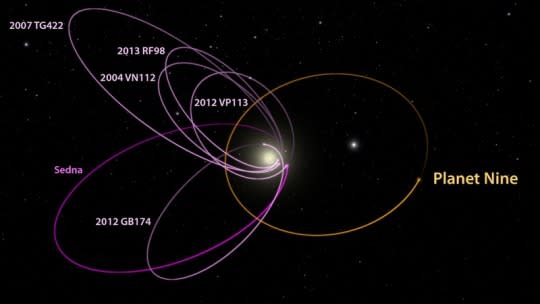Planet Nine? Evidence Grows for Big Addition to Solar System

(Image: Caltech/R. Hurt (IPAC))
A decade ago Mike Brown helped get Pluto demoted from a “planet” to a mere “dwarf planet.” Now the astronomer and one of his CalTech colleagues may have plotted the orbit of a new ninth planet in our solar system, dramatically larger than Pluto and much, much farther away.
As described by Brown and fellow astronomer Konstantin Batygin Wednesday in the Astronomical Journal, this new planet would be roughly 10 times the size of the Earth and would take as much as 20,000 years to make a single orbit around the sun. Its theoretical size — between the size of the Earth and Neptune — is unlike any other body in our solar system, but fits into the most common size of exoplanets detected in other systems.
Astronomers have been hunting for an undiscovered “Planet X” for nearly two centuries, generally without success. The notable exception: Neptune’s presence in our solar system was predicted by observing irregularities in the orbit of Uranus — and then later proven by observation through telescopes. Brown and Batygin’s finding is similar, in that they’ve done the math that strongly suggests the presence of a large planet in an weird orbit way beyond Pluto. But until someone spots the planet with a telescope, it’s just a theory.
Until recently, conventional wisdom held that we were done finding large objects in our solar system. In 2006, when Pluto was demoted, Brown recalls telling many people, “That’s it. That’s the end of planets. We get eight in this solar system and that will have to be enough.” A survey by NASA’s Widefield Infrared Survey Explorer (WISE) satellite essentially proved that there couldn’t be anything Saturn-sized or larger hiding out beyond Pluto.
Batygin and Brown’s theoretical “Planet Nine” — the scientists have even set up a website at findplanetnine.com — slides under the WISE size limit, because it’s smaller than Neptune. That far away from the sun, there’s very little light and heat, making it extraordinarily difficult to detect smaller objects. The search is already underway at ground-based telescopes around the world, but it’s a little like searching for a needle in a haystack in the dark. Brown and Batygin are using the Subaru telescope in Hawaii to search for the object, but it might take as much as five years for them to find it.
Cosmic clues
The roots of Brown and Batygin’s discovery come from another distant solar system object discovered by Brown. Sedna is a weird object on an odd orbit that doesn’t fit in with the behavior of other distant icy objects (including Pluto) in what’s called the Kuiper Belt. When astronomers Chad Trujillo and Scott Sheppard discovered a second Sedna-like object in a weird orbit, Brown and Batygin got suspicious.
As it turned out, the six most prominent objects in the far-outer reaches of the solar system all have orbits that point in the same direction and make their closest approach to the sun in very similar locations. The chances of that happening entirely by chance were estimated by Batygin as being, well, astronomical. All of a sudden, the scientists — who entered into the process hoping to disprove the hypothesis that there was an undiscovered big planet knocking around the outer solar system — suddenly started to wonder if it might actually be true. When they discovered that their projected Planet Nine accurately predicted the existence of some other weird distant solar-system objects, things really fell into place.

Planet Nine’s eccentric orbit. (Image: Caltech/R. Hurt (IPAC))
Still, without actual visual evidence, Planet Nine is just a theory — and many astronomers remain skeptical. Scott Sheppard told the Washington Post he gives it about a 60 percent chance of being real. Scientific American quotes planetary scientist Hal Levison as expressing great skepticism: “I have seen many, many such claims in my career, and all of them have been wrong.” Brown is (not surprisingly) more confident in his discovery, putting his chances at 90 percent. And theorist Alessandro Morbidelli was ebuillient, telling the New York Times: “I would bet money. I would bet 10,000 bucks.”
But is it a planet?
Given Brown’s unique status as the self-proclaimed killer of Pluto, it worth considering whether such an odd object at the far reaches of the solar system can meet our current definition of a planet. Brown made the case on his own web site: “No matter where it is, the one thing we know for sure about Planet Nine is that it is dominating the outer edge of the solar system,” he wrote. “That is enough to make it a planet by anyone’s calculation.”
If Planet Nine does exist, what does it look like? That’s still up for grabs. Brown has suggested it might be an icy, rocky core with a tenuous atmosphere — the failed core of a wannabe gas giant. It could also be more like Uranus or Neptune, a rocky core with a more sizeable gas envelope around it.
Even if Planet Nine is observed soon, it will be a while before we know more about it. The planet would be so far away that it would probably take us many decades before we could even consider sending a probe to reach it. (Consider that we just visited Pluto via the New Horizons spacecraft — a mission that took nearly a decade just to reach its destination, and that this new planet is many times farther away than that.) As always, every new discovery just leads astronomers to new questions.
[Jason Snell hosts the Liftoff podcast on Relay FM and regularly writes about technology at Six Colors.]

